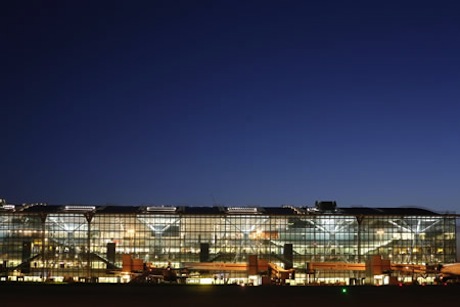A Week at the Airport
Extract
In the cloudless dawn, a sequence of planes, each visible as a single diamond, had lined up at different heights, like pupils in a school photo, on their final approach to the north runway. Their wings unfolded themselves into elaborate and unlikely arrangements of irregularly sized steel grey panels. Having avoided the earth for so long, wheels that had last touched the ground in San Francisco or Mumbai hesitated and slowed almost to a standstill as they arched and prepared to greet the rubber-stained English tarmac with a burst of smoke that made manifest their planes’ speed and weight.

With the aggressive whistling of their engines, the airborne visitors appeared to be rebuking this domestic English morning for its somnolence. They were like a delivery person who cannot resist pushing a little too insistently and vengefully on the door bell of a still-slumbering household. All around them, the M4 corridor was waking up reluctantly. There were kettles being switched on in Reading, suits being ironed in Slough, children unfurling themselves beneath their Thomas the Tank Engine duvets in Staines.
Yet for the passengers in the 747 now nearing the airfield, the day was already well advanced. Many would have woken up several hours before to catch their plane crossing over Thurso at the northernmost tip of Scotland, a remote-sounding destination for those in London’s suburbs, but like the doorstep after a journey over the Canadian icelands and the moonlit northern pole. Breakfast would have kept time with the airliner’s progress down the spine of the kingdom: a struggle with a small box of cornflakes over Edinburgh, an omelette studded with red peppers and mushroom near Newcastle, a stab at a peculiar looking fruit yoghurt over the unknowing Yorkshire Dales.
For the British Airways planes approaching Terminal 5, this was a return to their home base, like the final run up the Plymouth Sound for their eighteenth century naval predecessors. Having long been guests on foreign aprons, allotted awkward and remote slots at O’Hare or LAX, lost in boastfully long lines of United and Delta aircraft, it was now their turn to have the superiority of numbers and line up in perfect symmetry along the back of satellite B.
Sibling 747s that had only recently been separated out across the world parked wing tip to wing tip, Johannesburg next to Delhi, Sydney next to Phoenix. Repetition lent their fuselage designs a new beauty; the eye could follow an identical sequence of motifs down a fifteen-strong line of dolphin-like white bodies, the resulting aesthetic effect only enhanced by the knowledge that each had cost some 250 million dollars, and that what lay before one was therefore a symbol not just of the modern era’s daunting technical intelligence but also of its prodigious and inconceivable wealth.
As every plane took up its position, a choreographed dance began. A passenger walkway rolled forward and closed its rubber mouth in a hesitant kiss over the forward left-hand door. A member of the ground staff tapped at the window, a colleague inside released the airlock and the two airline personnel exchanged a brief and uninterested hello, the sort of casual greeting one might have expected between office workers returning to adjacent desks after lunch, rather than the encomium that would more fittingly have marked the end of an 11,000 kilometre journey from the other side of the globe. Then again, we are unlikely to hear anything more loquacious in the next century when, at the close of a nine-month journey, our shuttle docks in the eerie red midday light at a spaceport in Mars’s Cydonian hills and a fellowHomo Sapiens knocks at the gold-tinted window of our craft.